|
|
|
Sort Order |
|
|
|
Items / Page
|
|
|
|
|
|
|
| Srl | Item |
| 1 |
ID:
180856
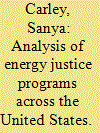

|
|
|
|
|
| Summary/Abstract |
The energy transition that is developing across the United States is producing both winners and losers. While some individuals, households and communities are reaping the benefits of the move toward cleaner, renewable sources of energy, others are experiencing its adverse effects, such as disruptions to labor markets, higher energy prices, and pollution and health burdens. To address these disparities, policymakers are increasingly calling for energy justice. However, there is scant scholarly literature on either the prevalence or characteristics of energy justice programs that already exist. Here we show that energy justice programs are both quite widespread and diverse across the United States, are most often led by nonprofit organizations rather than government agencies, and, while many share common missions, programs entail unique and often innovative strategies to achieve their objectives. The analysis lends important insights into current energy justice programs, but we argue deeper evaluation is necessary to identify which efforts are efficacious.
|
|
|
|
|
|
|
|
|
|
|
|
|
|
|
|
| 2 |
ID:
166511


|
|
|
|
|
| Summary/Abstract |
In the layperson's imagination, energy is an abstract concept, disconnected from social and ecological realities, while in reality it is the cornerstone of all human and natural interactions; thus, energy policy can be seen as a representation of how part of nature has been appropriated, managed, and represented. This article offers an analysis of Colombian energy policy through its National Energy Plans, and an examination of the energy transitions that the country has experienced in the last forty years. The analysis of the Colombian case demonstrates that the central objective of energy planning and its institutional framework has been the advancement and maximization of the exploitation of energy resources for export purposes, instead of providing a guide to reorganize the system towards the reduction of energy consumption, the progressive replacement of non-renewable resources in favor of renewable sources, or energy justice.
|
|
|
|
|
|
|
|
|
|
|
|
|
|
|
|
| 3 |
ID:
166431
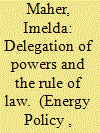

|
|
|
|
|
| Summary/Abstract |
This article examines the legal frameworks surrounding the EU energy policy and its associated institutional architecture. Particular focus is on the Agency for Cooperation of Energy Regulators (ACER). Taking stock of ongoing debates concerning the Energy Union and recently proposed reforms, the purpose of this analysis is twofold. First, from a theoretical perspective, this article explores the limits of the principal/agent model for European integration after the Treaty of Lisbon. It argues that a rule of law analysis should supplement this model in order to improve the encapsulation of the complexities of delegation in policy areas such as energy. Second, this will enable a reflection on the principle of energy justice and the way in which it is articulated by policy and governance changes in the EU.
|
|
|
|
|
|
|
|
|
|
|
|
|
|
|
|
| 4 |
ID:
177431


|
|
|
|
|
| Summary/Abstract |
The transition to a digital, decarbonised, and decentralised energy system presents both risks and opportunities for the domestic consumer. Domestic ‘demand-side response’ (DSR), where household electrical consumption adjusts in response to external signals, has been envisioned in different ways with several trials demonstrating that DSR often has variegated and uneven consumer outcomes. This plurality of outcomes raises questions about the ‘winners’ and ‘losers’ of pursuing such policies and thus brings them into the realm of energy justice – a framing that seeks to understand the ethical implications of energy systems. This paper, based on an extensive review of current academic literature, evaluates the normative implications of DSR in relation to the eight principles of energy justice proposed by Sovacool and Dworkin (2015). Whilst there are several ways that DSR may create opportunities for furthering energy justice, there are also multiple risks of injustice, with much depending on how particular DSR programmes are designed and the presence or absence of sufficient policies to mitigate regressive outcomes. Further empirical research is required to better understand the conditions through which DSR can contribute to energy justice. We conclude by offering policy recommendations for those developing DSR or consumer protection policies related to DSR rollout.
|
|
|
|
|
|
|
|
|
|
|
|
|
|
|
|
| 5 |
ID:
177171
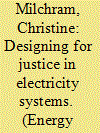

|
|
|
|
|
| Summary/Abstract |
In future urban energy systems, smart grid systems will be crucial for the integration of renewable energy. However, their deployment has moral implications, for example regarding data privacy, user autonomy, or distribution of responsibilities. ‘Energy justice’ is one of the most comprehensive frameworks to address these implications, but remains limited regarding smart grids, and regarding concrete guidelines for designers and policymakers. In this paper, we fill this gap by answering the following research question: How do design choices in smart grid projects impact energy justice? Thereby, four smart grid pilot projects are evaluated in a comparative qualitative case study research design. Data was collected through semi-structured interviews and a content analysis. Our findings contribute to the energy justice literature with insights regarding the design for distributive, recognition, and procedural justice. They underscore the importance of fairness in data governance, participatory design, user control and autonomy, technology inclusiveness, and the design for expansion and replication. Future research should explore the feasibility to govern smart grids as commons and the relationship between trust and perceptions of justice. We conclude with policy recommendations for funding future smart grid experiments and for facilitating the implementation of storage through electricity sector regulation.
|
|
|
|
|
|
|
|
|
|
|
|
|
|
|
|
| 6 |
ID:
179703
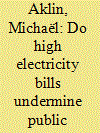

|
|
|
|
|
| Summary/Abstract |
The clean energy transition has long been framed in terms of its technological and economic feasibility. An increasingly salient constraint lies in its political feasibility. The transition requires vigorous public support to be completed. Yet increased consumer costs associated with the deployment of renewable electricity could make voters - and, by extension, governments - less supportive of it. As a result, overly aggressive government support for renewables could lead to its own downfall. To examine this threat, I document two stylized facts. First, the expansion of renewable electricity capacity has been followed by an increase in household electricity bills, and this has mostly happened because of energy-specific taxes. An increase of renewable electricity capacity by one within-country standard deviation raises a typical household's bill by €5.7 per MWh (95% CI: [3, 8.3]), most of which comes from an increase in non-VAT taxes (+€3.8/MWh [2.6; 5.1]). Second, these taxes have hurt popular support for aggressive renewable energy policy. An increase of non-VAT taxes by one standard deviation increases the share of people who find renewable energy too ambitious by 0.7 percentage points (95% CI: [0.1; 1.3]). Climbing costs could therefore undermine further political support toward renewable electricity deployment and threaten its contribution to greenhouse gas reductions.
|
|
|
|
|
|
|
|
|
|
|
|
|
|
|
|
| 7 |
ID:
166347
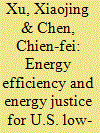

|
|
|
|
|
| Summary/Abstract |
Energy poverty intertwines with the issues of energy inequality and energy justice, presenting a particular challenge for low-income households (LIHs). This study explores energy justice in the U.S. through the lens of several interconnected questions: Do energy assistance programs have adequate participation rates? How accessible are energy efficiency (EE) appliances? Are there different energy practices across income groups? How does time schedule of energy practices differ across income groups, and how is it connected to energy demand flexibility? Based on two representative data sets, this study finds that affordability and accessibility remain serious problems for LIHs. LIHs have lower participation rates in many EE programs and own fewer EE appliances and smart grid technologies. Additionally, thermostat control strategies are different across income levels. LIHs tend to set one fixed temperature, even when they own a programmable thermostat, which is less energy efficient. LIHs engage in more energy practices throughout the daytime than their counterparts and show the least pronounced morning and evening peaks, indicating a relatively inflexible schedule and barriers to accepting demand response programs. This study concludes with policy implications for making energy more affordable, accessible, flexible, and better for the environment, while being fair to those often underserved.
|
|
|
|
|
|
|
|
|
|
|
|
|
|
|
|
| 8 |
ID:
181446
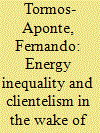

|
|
|
|
|
| Summary/Abstract |
Do social vulnerabilities and ruling party support shape government responsiveness in times of disasters? The 2017 hurricane María territory-wide power outage, the second longest in world history, is a tragic natural experiment that provides a unique opportunity to examine the determinants of government responsiveness during disaster recovery processes. We use data on power restoration crew deployments (N = 18,614 deployments), a novel measure of government responsiveness, and a new social vulnerability index to assess the determinants of government responsiveness in the wake of disasters. We find that communities with ties to the ruling party elicit greater government responsiveness while socially vulnerable communities are less likely to be prioritized during the disaster relief efforts, controlling for disaster damage as well as logistical, economic, and essential service recovery priorities. Existing power restoration policies place larger burdens on marginalized communities, motivating the need for including power restoration to vulnerable communities among restoration priorities.
|
|
|
|
|
|
|
|
|
|
|
|
|
|
|
|
| 9 |
ID:
193737


|
|
|
|
|
| Summary/Abstract |
Given the growing salience of energy transition conflicts, policymakers need better tools to explain, prevent, and resolve them. The concept of energy justice highlights the normative direction of the energy system, and therefore, we examined the offshore wind farm siting conflict in Yeonggwang-gun, South Korea, through the lens of energy justice. In this study, we interviewed representatives of local stakeholder groups relevant to offshore wind farms and conducted text-mining analysis to extract the primary opinions of stakeholders. Through text-analysis, four primary factors were identified and discussed in relation to energy justice: gillnet fishing, consultation with the fishing village cooperative, damage by private developers, and a government-led conditional agreement. This mixed-method approach showed that the voices of fishing communities correlate with the four tenets of energy justice—distributional, procedural, recognition, and restorative justice. We discuss how recognition and restorative justice explain energy transition conflict under inadequate policy arrangements in South Korea, where little has been investigated in energy justice literature. By filling the gaps in energy transition conflict, we suggest inclusive policy strategies, revisiting the meaning and utility of participatory planning, scoping methods for Environmental and Social Impact Assessments, and just transition.
|
|
|
|
|
|
|
|
|
|
|
|
|
|
|
|
| 10 |
ID:
150744


|
|
|
|
|
| Summary/Abstract |
Ecuador's progressive Yasuní-ITT Initiative, operational 2007 to 2013, would have left almost one billion barrels of crude oil locked in perpetuity beneath one of the most intact and diverse nature reserves on the planet. The project attempted to “strand” these oil assets in order to protect biodiversity, respect the territory of indigenous peoples, combat climate change, and encourage more sustainable economic development. The Yasuní-ITT proposal would have had the international community pay Ecuador $3.6 billion—roughly half the value of the oil found there—in exchange for not developing the Ishpingo Tambococha Tiputini (ITT) oilfields. Funds would have been placed into social and environmental development programs and the promotion of domestic renewable energy. Instead, the project collected only $13 million and succumbed to a series of challenges including limited financing, intense political pressure, a national commitment to oil, and carbon leakage. This article summarizes the history, benefits, and insurmountable obstacles facing the Yasuní-ITT Initiative and presents six broader lessons and implications for climate and energy analysts, practitioners, and policymakers. It questions the political viability of and serves as a stark warning against those promoting and advocating policies centered on carbon budgets, stranded assets, negative emissions, and carbon revenue streams.
|
|
|
|
|
|
|
|
|
|
|
|
|
|
|
|
| 11 |
ID:
181783
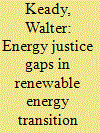

|
|
|
|
|
| Summary/Abstract |
This study examines how renewable energy policies in Vermont address energy vulnerability and energy justice. Using an anti-resilience framework, and drawing on 569 surveys and 18 interviews statewide, our results demonstrate higher energy vulnerability—lack of access to sufficient and affordable energy—among respondents who are low-income, non-white, and renters. Low-income and renter respondents were over three times more likely, and non-white respondents were seven times more likely, to report going without heat. While Vermont is regarded as a renewable energy leader, its current policies do not equitably distribute household transition benefits (HTBs) to address vulnerability. Our results show that non-white respondents were seven times less likely than white respondents to report having solar panels and renters were three times less likely than homeowners to report having solar panels. Interviews also reveal HTBs are available mostly to high-income households. We argue that these disparities may result from structural discrimination and policies that distribute HTBs to households with disposable income and property rights. The unequal distribution of this ‘investment capital’ prevents widespread access for non-white, low-income, and renting households. Following an anti-resilience framework, we propose alternative policy frameworks that center justice within energy transition policy making.
|
|
|
|
|
|
|
|
|
|
|
|
|
|
|
|
| 12 |
ID:
179660
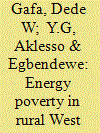

|
|
|
|
|
| Summary/Abstract |
This research evaluates the levels and the determinants of energy poverty in rural West Africa using countrywide primary data for Senegal and Togo. The study estimates and compares various indicators for measuring energy poverty and a newly proposed multidimensional measure. The results suggest that rural energy poverty levels vary from 31.2 to 98.5 percent in Senegal and 53.5 to 98.8 percent in Togo. Measures that are based on per capita energy consumption generate higher energy poverty rates in rural Senegal than Togo due to the relative scarcity of fire wood and the relatively larger household size in Senegal. Multidimensional and expenditure-based energy measures generate higher energy poverty in rural Togo than Senegal, reflecting the higher per capita income and greater access to modern energy sources in Senegal compared to Togo. Household income, fertility and the type of fuel used are the main drivers of household energy poverty in both countries. Furthermore, rural households tend to have greater energy consumption when the decisions about energy purchase are made jointly by male and female household members. Thus, public policies that improve rural households' income, foster women's participation in decision-making, and provide affordable energy would help reduce energy poverty in both countries.
|
|
|
|
|
|
|
|
|
|
|
|
|
|
|
|
| 13 |
ID:
186458


|
|
|
|
|
| Summary/Abstract |
Slovakia is one of the few countries with an official energy poverty definition. Nevertheless, it is listed among the ten most lagging EU Member States in terms of progress in alleviating energy poverty. There are also concerns about the fairness of measures to combat it. This paper builds on the energy justice perspective and a spatially-sensitive evaluation to critically analyse Slovak policies directly and indirectly tackling the issue. Do they reflect the three fundamental pillars of energy justice? And, given the issue's uneven socio-spatial occurrence in the country, are these policies designed and implemented to reduce pre-existing inequalities? We reveal that the multidimensional nature and specificities of energy poverty in Slovakia remain misrecognized in major policies. Moreover, there are shortcomings in the policies' distributional and participatory aspects. Most importantly, social welfare benefits are hard to access for energy-poor households, as are energy efficiency support schemes. Though some policies address dimensions linked to the issue, energy poverty's uneven incidence is not reflected. We conclude by pointing to the untapped potential of major policies in solving the problem.
|
|
|
|
|
|
|
|
|
|
|
|
|
|
|
|
| 14 |
ID:
192792
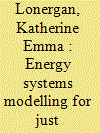

|
|
|
|
|
| Summary/Abstract |
Policymaking increasingly targets an energy transition that is not only low cost and low carbon, but also just. While energy system models have been useful policymaking tools towards achieving the first two objectives, it is yet unclear to what extent they can also support a just transition. Here, we review 73 recent energy systems modelling studies using an analytical coding frame and observe a diversity of approaches to account for energy justice. While models do show promise in being able to support a just transition, especially in terms of assessing distributional outcomes, many of the approaches in the literature are poorly connected to current energy justice goals and discourses, decreasing the studies’ policy relevance and leaving policymakers with suboptimal planning support. Based on our results, we suggest eight actions for modellers to increase the policy relevance of their studies, which include more direct engagement with policy and research discourses, developing location-specific case studies, leveraging public participation in the modelling process, and considering asset decommissioning.
|
|
|
|
|
|
|
|
|
|
|
|
|
|
|
|
| 15 |
ID:
166565
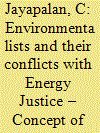

|
|
|
|
|
| Summary/Abstract |
This paper describes how a green energy surplus region changed over the years to a thermal energy-mix, driven by environmentalist forces’ strong opposition to Hydro-Electric Power Projects (HEPPs) in Kerala, India. The specific instance of the proposed Athirappilly HEPP is discussed against the background of the opposition of environmentalists and other sympathetic associations. The strong opposition to HEPPs in specific local contexts has led to increased emissions in other places. The tenets of Energy Justice – distributional, procedural, recognition and cosmopolitan – have been challenged by the environmentalists’ movement against the Athirappilly HEPP. The inherent conflicts between Environment Law and Climate Law on the one hand and the principles of Energy Justice and Law on the other are pointed out. The concept of “Power-Environ” is introduced and characterized, and its relation to Energy Justice and Law is explored in the policy context. The concept proposed here serves as a foundation for realizing parsimonious and effective representation of the opposition to HEPPs, and ushering Energy Justice and Law. The use of this concept, as an integrated whole founded on the principles of Energy Justice and Law, should facilitate balanced policy-making in the Energy sector, especially in India and hopefully across the world too.
|
|
|
|
|
|
|
|
|
|
|
|
|
|
|
|
| 16 |
ID:
186437
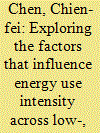

|
|
|
|
|
| Summary/Abstract |
This study examines the relationships between energy use intensity (EUI), which is considered to be an indicator of energy efficiency, and dwelling or housing characteristics, technology (appliances), socio-demographic characteristics, geographic factors, and energy-related behavioral actions. Additionally, it explores whether these relationships vary across low-, medium-, and high-income households. The study is based on regression analyses conducted on a representative sample of households, the 2015 U.S. Residential Energy Consumption Survey. Overall, the analysis revealed two important findings. First, residential energy use intensity is shaped significantly by housing characteristics, socio-demographic factors, technology, and energy-related behavioral actions. Second, the relationships between the factors examined and energy use intensity vary quite substantially across income groups. Lower income households have a higher EUI than higher income households. The policy implications of these findings are that reducing EUI in the residential sector, which may help with addressing energy burdens and poverty among low-income households, will require paying careful attention to these factors and their dynamic impacts across income groups.
|
|
|
|
|
|
|
|
|
|
|
|
|
|
|
|
| 17 |
ID:
176865
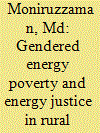

|
|
|
|
|
| Summary/Abstract |
This paper investigates the relationship between gender and energy poverty as a matter of energy (in)justice. Energy poverty is generally conceived of and measured at the household level, obscuring potential gender differences in the costs and benefits of energy and fuel usage and in access to energy services. Drawing on qualitative work with women, men and community leaders in a case study in rural Bangladesh, we show that men and women's energy poverty is different when assessed in terms of a multi-dimensional, service-based definition of energy poverty, and argue that along with the differential impacts of the use of traditional fuels, this constitutes gender-based distributional energy injustice. We further investigate how this injustice is connected to a lack of procedural energy justice and a lack of recognition for women, especially those living in rural poverty, at different scales of governance, from the household to national energy policy. We argue that an energy justice lens is valuable in analysing the gender-energy nexus to reveal its social dynamics, and in pointing to policy directions to ameliorate women's energy poverty that are beyond the solely technical.
|
|
|
|
|
|
|
|
|
|
|
|
|
|
|
|
| 18 |
ID:
168685
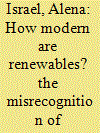

|
|
|
|
|
| Summary/Abstract |
The ubiquitous claim for ‘modern’ energy access leads to profound transformative dynamics in energy systems in the global South. However, the policies' effects on existing socio-technical forms of energy provision must be considered. In this paper, we highlight the case of Peru, where the ‘modernisation’ of the energy systems endangers an established practice of renewable energy use. In the city of Arequipa, households widely rely on solar water heaters that have been manufactured locally since the 1930s. Applying an institutionalist approach, we analyse actors and institutions of this local energy system. We identify a disconnection of existing renewable energy practices from national policies and their marginalisation by international cooperation agencies. We show how the misrecognition jeopardises the livelihood of people involved and provokes the loss of contextualised innovation potentials. Thus, we discover a dichotomy of ‘modern’ energy policies and ‘traditional’ practices of solar thermal energy. Based on this case study, we therefore stress the need to include local energy practices into the energy policy framework for ensuring technological and social gains. We also emphasise the need to generally shift away from a top-down approach with generalised globally applicable solutions to more inclusive governance and policy formulation.
|
|
|
|
|
|
|
|
|
|
|
|
|
|
|
|
| 19 |
ID:
177134
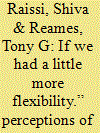

|
|
|
|
|
| Summary/Abstract |
Since 1976, the U.S. Department of Energy's Weatherization Assistance Program (WAP) has provided state block grants for no-to low-cost energy efficiency retrofits for more than 7 million low-income households. Yet, more than 35 million households meet income-qualifications for the program. While numerous program evaluations demonstrate the energy- and non-energy-related benefits of WAP, some argue low uptake, and a low rate of return on retrofit costs to energy savings. To further our understanding of government-funded low-income energy efficiency program implementation, we examined local agency-level perceptions of challenges and opportunities. Findings from semi-structured interviews with program managers, representing one-third of Michigan's WAP funding and retrofit production, suggest three funding-related challenges: funding instability; funding allocation formula; and limited advertising and marketing funding, and two regulatory-related challenges: cumbersome paperwork and restrictive guidelines. Program managers also identified three workaround opportunities: collaboration with utilities and other organizations; intra-agency innovation and integration; and strategic productivity and per unit spending. Lastly, one recommendation for further exploration would be testing the efficacy of granting local agencies greater flexibility to work around funding and regulatory challenges to increase the number of households weatherized, reduce long waitlists and deferral rates, and use staff time more efficiently.
|
|
|
|
|
|
|
|
|
|
|
|
|
|
|
|
| 20 |
ID:
194689


|
|
|
|
|
| Summary/Abstract |
In the 2021 Infrastructure Investment and Jobs Act (IIJA) and the 2022 Inflation Reduction Act (IRA), the United States (US) Congress placed a major bet on the importance of household actions, and the incentives for these actions may yield disproportionately large emissions reductions. Modeling estimates from the Rapid Energy Policy Evaluation and Analysis Toolkit (REPEAT) suggest that the IRA's $331 billion investment can reduce carbon emissions by as much as 42% below a 2005 baseline by 2030, assuming a low-friction economic environment. To evaluate the role of household actions, we use a two-part method: 1) Policy analyses of the IRA and IIJA to identify household incentives; 2) Secondary data analysis of REPEAT's policy models to identify the potential for emissions reductions associated with household action. We find that $39 billion, or 12% of climate and energy funds in the IRA and $4.3 billion or 5.7% of clean energy and power funds in the IIJA, target voluntary household actions, and that these actions contribute 40% of the cumulative emissions reductions under the IRA and IIJA, assuming a mid-range scenario for uptake. The importance of household actions to achieving IRA and IIJA's emissions reduction goals suggests that actual impacts will likely vary by behavioral plasticity, and that program design should reflect social and behavioral science insights.
|
|
|
|
|
|
|
|
|
|
|
|
|
|
|
|
|
|
|
|
|